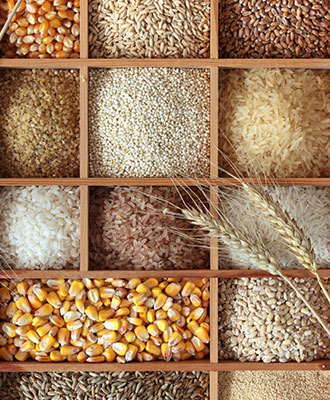Last week we took a look at the dangers of simple carbohydrates and refined grains. If that left you looking at your pantry thinking ‘what can I eat then?’ it’s time to get experimental with your grains! Yes, it’s possible to buy wholegrain pasta, but if you’re really keen on making the swap, going to the effort of seeking out these little-known wonders is worth it.

Foods with a high Glycemic Index (like refined flour) are digested fast and dump their sugar (glucose) content on the body all at once, resulting in spiked blood sugar and problems with insulin production and energy and fat conversion. Low GI foods (less than 55) keep blood sugar steady because they contain enough fat or fiber to slow down the conversion to glucose. This means you get a sustained release of energy in the body, supporting normal hunger patterns and giving a well-needed break to the liver and adrenals. To give you an idea, whole wheat kernels have a GI of 30, while a plain white bagel sits at 72. Brown rice 50, white rice 89. Get the idea?
A whole grain is the seed of a plant and is made up of three edible parts; the bran, the germ and the endosperm. Bran contains antioxidants, vitamin B and fiber, while the germ contains many B vitamins, some protein, minerals and healthy fats. The endosperm (the bit used to make refined flour) contains starchy carbohydrates, some proteins and only small amounts of vitamins and minerals.
Apart from all of this, they taste great and are a much more complex and interesting addition to a meal than your standard processed wheat.
1. Amaranth*
Huge nutritional value and a protein powerhouse with cholesterol-lowering potential.
2. Kamut
A great source of protein and nutrients like selenium, zinc and magnesium.
3. Millet*
A good source of protein and great for keeping blood sugar steady. Can be prepared like polenta or rice or ground into flour for baking!
4. Quinoa*
A seed high in minerals and containing all 9 amino acids, quinoa is a great source of protein and is great for detoxing and digestion. It’s super easy to cook with and can be added to almost anything.
5. Buckwheat*
Actually a herb, buckwheat groats can be cooked like rice, or ground to make flour. Buckwheat lowers blood glucose levels and can also help lower cholesterol. Groats are great in savory dishes, made into a sweet porridge or tossed raw into your granola mix.
6. The Rice Family*
Red rice has long been used for medicinal properties in Asia, for indigestion, blood circulation and spleen health. Brown Rice can aid digestion while Black Rice is nutrient loaded and supports the kidneys. Wild Rice is high in essential minerals and has calming properties on the body.
7. The Wheat Family
Freekah is early-harvested wheat that has been roasted with loads of fiber and protein and a low GI while Farro and spelt are loaded with fiber and are commonly used in lots of Italian dishes. Barley is high in fiber and has a very low GI. Bulgur is made by boiling, drying and cracking wheat kernels, is incredibly versatile and cooks as quickly as pasta.
** These grains are gluten free which mean they’re great for people with a gluten allergy or intolerance, are easier to digest and great for overall gut health.















